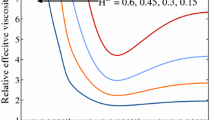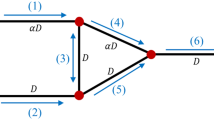Abstract
We show that large microvascular networks with realistic topologies, geometries, boundary conditions, and constitutive laws can exhibit many steady-state flow configurations. This is in direct contrast to most previous studies which have assumed, implicitly or explicitly, that a given network can only possess one equilibrium state. While our techniques are general and can be applied to any network, we focus on two distinct network types that model human tissues: perturbed honeycomb networks and random networks generated from Voronoi diagrams. We demonstrate that the disparity between observed and predicted flow directions reported in previous studies might be attributable to the presence of multiple equilibria. We show that the pathway effect, in which hematocrit is steadily increased along a series of diverging junctions, has important implications for equilibrium discovery, and that our estimates of the number of equilibria supported by these networks are conservative. If a more complete description of the plasma skimming effect that captures red blood cell allocation at junctions with high feed hematocrit were to be obtained empirically, then the number of equilibria found by our approach would at worst remain the same and would in all likelihood increase significantly.





Similar content being viewed by others
References
Carr RT, Lacoin M (2000) Nonlinear dynamics of microvascular blood flow. Ann Biomed Eng 28(6):641–652
Carr RT, Geddes JB, Wu F (2005) Oscillations in a simple microvascular network. Ann Biomed Eng 33(6):764–771
Davis JM (2014) On the linear stability of blood flow through model capillary networks. Bull Math Biol 76(12):2985–3015
Davis JM, Pozrikidis C (2010) Numerical simulation of unsteady blood flow through capillary networks. Bull Math Biol 73(8):1857–1880
Davis JM, Pozrikidis C (2014) Self-sustained oscillations in blood flow through a honeycomb capillary network. Bull Math Biol 76(9):2217–2237
Dellimore JW, Dunlop MJ, Canham PB (1983) Ratio of cells and plasma in blood flowing past branches in small plastic channels. Am J Physiol 244(5):H635–H643
Einstein A (1906) Eine neue bestimmung der moleküldimensionen. Annalen der Physik 19:289–306
Fåhræus R, Lindqvist T (1931) The viscosity of blood in narrow capillary tubes. J Physiol 96:562–568
Fenton BM, Carr RT, Cokelet GR (1985) Nonuniform red cell distribution in 20 to 100 \(\mu \)m bifurcations. Microvasc Res 29(1):103–126
Fung YC (1973) Stochastic flow in capillary blood vessels. Microvasc Res 5(1):34–48
Ganesan P, He S, Xu H (2010a) Analysis of retinal circulation using an image-based network model of retinal vasculature. Microvasc Res 80(1):99–109
Ganesan P, He S, Xu H (2010b) Development of an image-based network model of retinal vasculature. Ann Biomed Eng 38:1566
Gardner D, Li Y, Small B, Geddes JB, Carr RT (2010) Multiple equilibrium states in a micro-vascular network. Math Biosci 227:117–124
Geddes JB, Carr RT, Karst N, Wu F (2007) The onset of oscillations in microvascular blood flow. SIAM J Appl Dyn Syst 6(4):694–727
Geddes JB, Carr RT, Wu F, Lao Y, Maher M (2010a) Blood flow in microvascular networks: a study in nonlinear biology. Chaos: an interdisciplinary. J Nonlinear Sci 20(4):045123
Geddes JG, Storey BD, Gardner D, Carr RT (2010b) Bistability in a simple fluid network due to viscosity contrast. Phys Rev E 81:046316
Karst NJ, Storey BD, Geddes JB (2014) Spontaneous oscillations in simple fluid networks. SIAM J Appl Dyn Syst 13(1):157–180
Karst NJ, Storey BD, Geddes JB (2015) Oscillations and multiple equilibria in microvascular blood flow. Bull Math Biol 77:1–24
Kiani MF, Pries AR, Hsu LL, Sarelius IH, Cokelet GR (1994) Fluctuations in microvascular blood flow parameters caused by hemodynamic mechanisms. Am J Physiol 266(5 Pt 2):H1822–H1828
Klitzman B, Johnson PC (1982) Capillary network geometry and red cell distribution in hamster cremaster muscle. Am J Physiol 242(2):H211–H219
Mooney M (1951) The viscosity of a concentrated suspension of spherical particles. J Colloid Sci 6(2):162–170
Obrist D, Weber B, Buck A, Jenny P (2010) Red blood cell distribution in simplified capillary networks. Philos Trans R Soc A Math Phys Eng Sci 368(1921):2897–2918
Pozrikidis C (2009) Numerical simulation of blood flow through microvascular capillary networks. Bull Math Biol 71(6):1520–1541
Pries AR, Ley K, Claassen M, Gaehtgens P (1989) Red cell distribution at microvascular bifurcations. Microvasc Res 38(1):81–101
Pries AR, Secomb TW, Gaehtgens P, Gross JF (1990) Blood flow in microvascular networks. Experiments and simulation. Circ Res 67(4):826–834
Pries AR, Fritzsche A, Ley K, Gaehtgens P (1992) Redistribution of red blood cell flow in microcirculatory networks by hemodilution. Circ Res 70:1113–1121
Pries AR, Secomb TW, Gessner T, Sperandio MB, Gross JF, Gaehtgens P (1994) Resistance to blood flow in microvessels in vivo. Circ Res 75(5):904–915
Pries AR, Secomb TW, Gaehtgens P (1996) Biophysical aspects of blood flow in the microvasculature. Cardiovasc Res 32(4):654–667
Schmid-Schönbein GW, Skalak R, Usami S, Chien S (1980) Cell distribution in capillary networks. Microvasc Res 19(1):18–44
Secomb TW, Hsu R, Pries AR (1998) A model for red blood cell motion in glycocalyx-lined capillaries. Am J Physiol Heart Circ Physiol 274(3):H1016–H1022
Tawfik Y, Owens RG (2013) A mathematical and numerical investigation of the hemodynamical origins of oscillations in microvascular networks. Bull Math Biol 75(4):676–707
Acknowledgements
The authors would like to thank Brian Storey for helpful discussions throughout the early parts of this work, and an anonymous reviewer for his/her helpful comments on the initial submission of this manuscript.
Author information
Authors and Affiliations
Corresponding author
Rights and permissions
About this article
Cite this article
Karst, N.J., Geddes, J.B. & Carr, R.T. Model Microvascular Networks Can Have Many Equilibria. Bull Math Biol 79, 662–681 (2017). https://doi.org/10.1007/s11538-017-0251-z
Received:
Accepted:
Published:
Issue Date:
DOI: https://doi.org/10.1007/s11538-017-0251-z




